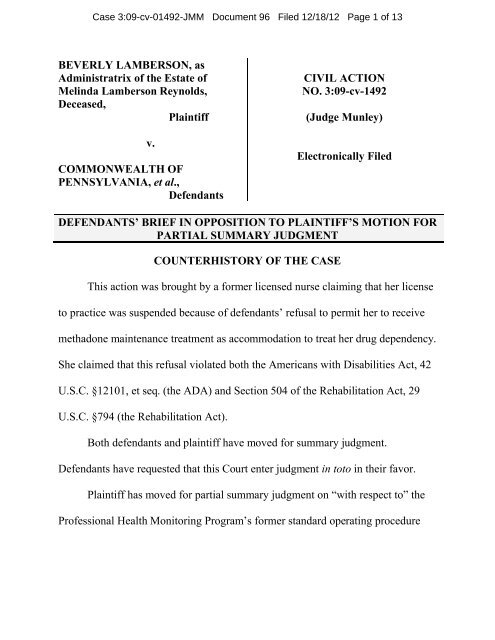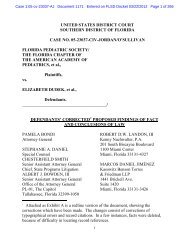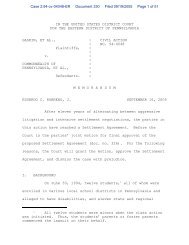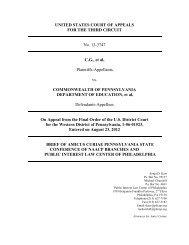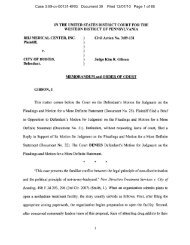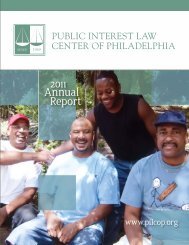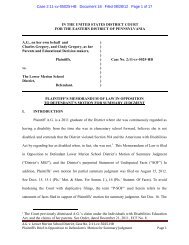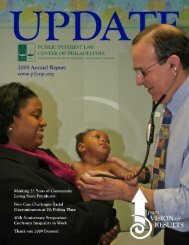Defendants' Brief in Support of Motion for Summary Judgment
Defendants' Brief in Support of Motion for Summary Judgment
Defendants' Brief in Support of Motion for Summary Judgment
Create successful ePaper yourself
Turn your PDF publications into a flip-book with our unique Google optimized e-Paper software.
Case 3:09-cv-01492-JMM Document 96 Filed 12/18/12 Page 1 <strong>of</strong> 13BEVERLY LAMBERSON, asAdm<strong>in</strong>istratrix <strong>of</strong> the Estate <strong>of</strong>Mel<strong>in</strong>da Lamberson Reynolds,Deceased,Pla<strong>in</strong>tiffv.COMMONWEALTH OFPENNSYLVANIA, et al.,DefendantsCIVIL ACTIONNO. 3:09-cv-1492(Judge Munley)Electronically FiledDEFENDANTS’ BRIEF IN OPPOSITION TO PLAINTIFF’S MOTION FORPARTIAL SUMMARY JUDGMENTCOUNTERHISTORY OF THE CASEThis action was brought by a <strong>for</strong>mer licensed nurse claim<strong>in</strong>g that her licenseto practice was suspended because <strong>of</strong> defendants’ refusal to permit her to receivemethadone ma<strong>in</strong>tenance treatment as accommodation to treat her drug dependency.She claimed that this refusal violated both the Americans with Disabilities Act, 42U.S.C. §12101, et seq. (the ADA) and Section 504 <strong>of</strong> the Rehabilitation Act, 29U.S.C. §794 (the Rehabilitation Act).Both defendants and pla<strong>in</strong>tiff have moved <strong>for</strong> summary judgment.Defendants have requested that this Court enter judgment <strong>in</strong> toto <strong>in</strong> their favor.Pla<strong>in</strong>tiff has moved <strong>for</strong> partial summary judgment on “with respect to” thePr<strong>of</strong>essional Health Monitor<strong>in</strong>g Program’s <strong>for</strong>mer standard operat<strong>in</strong>g procedure
Case 3:09-cv-01492-JMM Document 96 Filed 12/18/12 Page 3 <strong>of</strong> 13she is monitored <strong>for</strong> a time to be determ<strong>in</strong>ed” by the Nurs<strong>in</strong>g Board. Because Dr.Woody had determ<strong>in</strong>ed that there was a need <strong>for</strong> monitor<strong>in</strong>g and because an earlierattempt to have Reynolds’ enrolled <strong>in</strong> the voluntary recovery program wasunsuccessful, the State Department <strong>in</strong>itiated <strong>for</strong>mal action Reynolds <strong>in</strong> October2006. That proceed<strong>in</strong>g concluded <strong>in</strong> November 2006, when Reynolds, through herattorney, entered a consent agreement which suspended her nurs<strong>in</strong>g license <strong>for</strong>three years, and allowed her a three year probationary period.In May 2007, the Commonwealth filed a petition <strong>for</strong> appropriate reliefbecause Reynolds had not complied with the terms <strong>of</strong> the consent agreement.Follow<strong>in</strong>g a <strong>for</strong>mal hear<strong>in</strong>g on July 11, 2007, the hear<strong>in</strong>g exam<strong>in</strong>er recommendedsuspend<strong>in</strong>g Reynolds’ license <strong>for</strong> no less than three years with the suspension to bestayed when Reynolds provided the Board with an evaluation <strong>for</strong>m an approvedtreatment provider that she was safe to practice nurs<strong>in</strong>g.Reynolds never provided the Board with an evaluation. Instead, she broughtthis lawsuit.ARGUMENTI. INTRODUCTIONTitle II <strong>of</strong> the ADA provides that “no qualified <strong>in</strong>dividual with a disabilityshall, by reason <strong>of</strong> such disability, be excluded from participation <strong>in</strong> or be deniedthe benefits <strong>of</strong> the services, programs, or activities <strong>of</strong> a public entity, or be3
Case 3:09-cv-01492-JMM Document 96 Filed 12/18/12 Page 4 <strong>of</strong> 13subjected to discrim<strong>in</strong>ation by any such entity.” 42 U.S.C. § 12132. As pla<strong>in</strong>tiff <strong>in</strong>her brief recognizes, to state a claim under Title II <strong>of</strong> the ADA, a pla<strong>in</strong>tiff mustplead that (1) she has a disability; (2) she was otherwise qualified to participate <strong>in</strong>the program; and (3) she was denied the benefits <strong>of</strong> the program or otherwisesubjected to discrim<strong>in</strong>ation because <strong>of</strong> her disability. Chambers ex rel. Chambersv. Sch. Dist. <strong>of</strong> Phila. Bd. <strong>of</strong> Educ., 587 F.3d 176, 189 (3d Cir.2009). Under theRehabilitation Act, 29 U.S.C. § 794, the pla<strong>in</strong>tiff must also show that the programreceives “federal f<strong>in</strong>ancial assistance.” Because pla<strong>in</strong>tiff has failed to establish thesecond and third prong <strong>of</strong> her prima facie case, her motion <strong>for</strong> partial summaryjudgment on liability must be denied.II.MELINDA REYNOLDS WAS NOT OTHERWISE QUALIFIEDTO PRACTICE NURSINGDefendants argued <strong>in</strong> their open<strong>in</strong>g brief that, due to Reynolds’ long andcont<strong>in</strong>ued illegal use <strong>of</strong> benzodiazep<strong>in</strong>es, opiates and coca<strong>in</strong>e, she was not“otherwise qualified” to hold a state nurs<strong>in</strong>g license. Defendants’ <strong>Brief</strong> <strong>in</strong> <strong>Support</strong><strong>of</strong> <strong>Summary</strong> <strong>Judgment</strong> at 30-34 (Document 89). Pla<strong>in</strong>tiff argues <strong>in</strong> her motion,however, that, because defendants were not aware <strong>of</strong> pla<strong>in</strong>tiff’s illegal drug use onSeptember 18, 2007, when the Nurs<strong>in</strong>g Board suspended her license, this evidencemay not be used to show Reynolds’ lack <strong>of</strong> qualification, cit<strong>in</strong>g Bowers v. NCAA,475 F. 3d 524, 537 (3d Cir. 2007). While defendants recognize the hold<strong>in</strong>g <strong>in</strong>Bowers, it is not controll<strong>in</strong>g <strong>in</strong> this <strong>in</strong>stance.4
Case 3:09-cv-01492-JMM Document 96 Filed 12/18/12 Page 5 <strong>of</strong> 13Prior to the Bowers decision, the Third Circuit expressly held that that afteracquiredevidence may be used to determ<strong>in</strong>e the issue <strong>of</strong> whether a pla<strong>in</strong>tiff wasotherwise qualified. McNemar v. The Disney Store, Inc., 91 F.3d 610, 620-21 (3dCir.1996), cert. denied, 519 U.S. 1115 (1997)). McNemar was an ADAemployment case <strong>in</strong> which the defendant <strong>in</strong>troduced after-acquired evidence toshow that the pla<strong>in</strong>tiff was not qualified <strong>for</strong> the position from which he wasdismissed. In that case, the Court rejected the very argument pla<strong>in</strong>tiff makes here.The Court found that under the ADA the elements <strong>of</strong> pla<strong>in</strong>tiff’s threshold primafacie case did not turn on the knowledge <strong>of</strong> the defendant at the time the relevantdecision was made. That is because pla<strong>in</strong>tiff’s qualification is part <strong>of</strong> her primafacie case and has no bear<strong>in</strong>g on defendant’s motivation. Indeed, the Courtobserved that the argument on behalf <strong>of</strong> the pla<strong>in</strong>tiff “wants to mix apples – apla<strong>in</strong>tiff’s prima facie case – with oranges – a defendant’s non-discrim<strong>in</strong>atoryreason.”Id. at 621. Under McNemar, this Court should consider the undisputedafter-discovered evidence <strong>in</strong> determ<strong>in</strong><strong>in</strong>g whether pla<strong>in</strong>tiff was otherwise qualifiedto be a nurse.Not only is the issue more fully considered <strong>in</strong> McNemar than <strong>in</strong> Bowers,under the Third Circuit’s Internal Operat<strong>in</strong>g Procedure 9.1, McNemar iscontroll<strong>in</strong>g: “It is the tradition <strong>of</strong> this court that the hold<strong>in</strong>g <strong>of</strong> a panel <strong>in</strong> aprecedential op<strong>in</strong>ion is b<strong>in</strong>d<strong>in</strong>g on subsequent panels. Thus, no subsequent panel5
Case 3:09-cv-01492-JMM Document 96 Filed 12/18/12 Page 6 <strong>of</strong> 13overrules the hold<strong>in</strong>g <strong>in</strong> a precedential op<strong>in</strong>ion <strong>of</strong> a previous panel. Court en bancconsideration is required to do so.”Moreover, Bowers’ <strong>in</strong>terpretation <strong>of</strong> the ADA is questionable. As themajority <strong>of</strong> courts address<strong>in</strong>g the issue have held, after-acquired evidence may notbe used on the issue <strong>of</strong> the defendant’s motivation because, as pla<strong>in</strong>tiff correctlypo<strong>in</strong>ts out, “[d]efendants ‘could not have been motivated by knowledge [they] didnot have’….” Bowers 475 F.2d at 537. Pla<strong>in</strong>tiff’s Open<strong>in</strong>g <strong>Brief</strong> at 15. But theissue <strong>of</strong> whether Reynolds was an otherwise qualified <strong>in</strong>dividual is one <strong>of</strong> theelements <strong>in</strong> pla<strong>in</strong>tiff’s own prima facie case unrelated to the question <strong>of</strong>defendants’ motivation. It is only after pla<strong>in</strong>tiff establishes a prima facie case,<strong>in</strong>clud<strong>in</strong>g the fact that he or she is qualified, that the burden shifts to the defendantto articulate some legitimate, nondiscrim<strong>in</strong>atory reason <strong>for</strong> the its action. SeeWishk<strong>in</strong> v. Potter, 476 F.3d 180, 184-85 (3d Cir. 2007) (apply<strong>in</strong>g McDonnellDouglas burden shift<strong>in</strong>g analysis to a Rehabilitation Act claim). Indeed, if pla<strong>in</strong>tiffcannot show that Reynolds was otherwise qualified, she “cannot make out a primafacie case, and the burden never shifts to the defendant.” Equal EmploymentOpportunity Commission v. Fargo Assembly Co. 142 F.Supp.2d 1160, 1164(D.N.J. 2000).The substantial majority <strong>of</strong> other circuits have held similarly. E.g. Anaemev. Diagnostek, Inc., 164 F.3d 1275 (10th Cir.1999) (after-acquired evidence “was6
Case 3:09-cv-01492-JMM Document 96 Filed 12/18/12 Page 7 <strong>of</strong> 13nonetheless admissible to show that Pla<strong>in</strong>tiff's prima facie case was not supportedby a preponderance <strong>of</strong> the evidence.”); Gilty v. Village <strong>of</strong> Oak Park, 919 F.2d1247, 1251 (7th Cir .1990) (the determ<strong>in</strong>ation whether the pla<strong>in</strong>tiff is qualified“requires an objective analysis” <strong>in</strong> which “an employer's knowledge or lack <strong>of</strong>knowledge is <strong>of</strong> no relevance.”); Mantolete v. Bolger, 767 F.2d 1416, 1424) (9thCir.1985) (evidence was not admissible to enlarge the basis upon which the PostalService rejected the applicant, but it was admissible, even though after acquired, torebut the applicant's claim that she was physically qualified <strong>for</strong> the position).In addition, Reynolds should not be permitted to benefit from her ownmisconduct. The only reason that defendants were not aware <strong>of</strong> her actual drughistory was her own deception. In the voluntary recovery program Personal DataSheet that Reynolds signed on October 6, 2005, Reynolds disclosed only a s<strong>in</strong>gle<strong>in</strong>stance <strong>of</strong> tak<strong>in</strong>g Restoril, despite the fact that she had been <strong>in</strong> drug treatments<strong>in</strong>ce 1997, had been a hero<strong>in</strong> addict s<strong>in</strong>ce approximately 1977, had an addiction tobenzodiazep<strong>in</strong>es and had undergone detox from benzodiazep<strong>in</strong>es twiceunsuccessfully. Harris Deposition Exhibit 14. This personal data sheet was<strong>for</strong>warded to Dr. Woody and was part <strong>of</strong> the record he reviewed. Woody RecordMLR 17108-17116.Reynolds also made misrepresentations to Dr. Woody. Aga<strong>in</strong>, she told himonly <strong>of</strong> one <strong>in</strong>stance <strong>of</strong> her us<strong>in</strong>g Benzodiazep<strong>in</strong>es. Woody Record MLR 17037.7
Case 3:09-cv-01492-JMM Document 96 Filed 12/18/12 Page 8 <strong>of</strong> 13In addition, she said noth<strong>in</strong>g about her long-term hero<strong>in</strong> addiction, but claimed thather methadone treatment was <strong>for</strong> pa<strong>in</strong>. Woody Record MLR 17037-17038.She made further misrepresentations <strong>in</strong> her personal data sheet completed<strong>for</strong> the discipl<strong>in</strong>ary monitor<strong>in</strong>g unit signed on February 2, 2007. She (1) deniedthat any current or past crim<strong>in</strong>al action had been taken aga<strong>in</strong>st her; (2) did notprovide <strong>in</strong><strong>for</strong>mation about her prior Hero<strong>in</strong> use; (3) did not provide <strong>in</strong><strong>for</strong>mationthat her methadone ma<strong>in</strong>tenance began <strong>in</strong> 1997, and <strong>in</strong>stead stated that she startedher methadone ma<strong>in</strong>tenance <strong>in</strong> 2004. Reynolds PHMP File, MLR 940-948.F<strong>in</strong>ally, at the licens<strong>in</strong>g hear<strong>in</strong>g on July 11, 2007, she testified under oaththat she had been on methadone ma<strong>in</strong>tenance <strong>for</strong> less than four years and wastak<strong>in</strong>g methadone <strong>for</strong> pa<strong>in</strong>. Board Proceed<strong>in</strong>gs, MLR 22362-63, MLR 22365. Sheprovides no testimony about her 20 year hero<strong>in</strong> addiction. Board Proceed<strong>in</strong>gs,MLR 22349-22373. She said noth<strong>in</strong>g about her history <strong>of</strong> tak<strong>in</strong>g Benzodiazep<strong>in</strong>es.Thus, it is clear that, if defendants were not aware <strong>of</strong> Reynolds’ complete drughistory, it was because she failed to disclose it when requested.In Summers v. State Farm Mutual Automobile Insurance Co., 864 F.2d 700,708 (10 th Cir. 1988), the Court recognized the fundamental <strong>in</strong>justice <strong>of</strong> exclud<strong>in</strong>gafter-acquired evidence which was not known earlier because <strong>of</strong> the pla<strong>in</strong>tiff’sdeception:Four years later, State Farm ascerta<strong>in</strong>ed that there had been 150falsifications, <strong>of</strong> which occurred after Summers was brought back from8
Case 3:09-cv-01492-JMM Document 96 Filed 12/18/12 Page 9 <strong>of</strong> 13probation. To argue, as Summers does, that this after-acquired evidenceshould be ignored is utterly unrealistic. The present case is ak<strong>in</strong> to thehypothetical where<strong>in</strong> a company doctor is fired because <strong>of</strong> his age, race,religion, and sex and the company, <strong>in</strong> defend<strong>in</strong>g a civil rights action,thereafter discovers that the discharged employee was not a “doctor.” In ourview, the masquerad<strong>in</strong>g doctor would be entitled to no relief, and Summersis <strong>in</strong> no better position.Accord<strong>in</strong>gly, this Court should permit the use <strong>of</strong> after-acquired evidence to showthat Reynolds was not qualified to practice nurs<strong>in</strong>g. That evidence is undisputed,and alone precludes partial summary judgment <strong>in</strong> pla<strong>in</strong>tiff’s favor.III.PLAINITFF HAS PRODUCED NO EVIDENCE THATREYNOLDS WAS DENIED THE BENEFITS OF A NURSINGLICENSE BECAUSE OF THE FORMER PHMP METHADONEPOLICYPla<strong>in</strong>tiff asserts with no factual support that the PHMP caused Reynolds tobe excluded from the practice <strong>of</strong> nurs<strong>in</strong>g. With no cite to the record, pla<strong>in</strong>tiffstates, “Defendants did not exclude Reynolds on the basis <strong>of</strong> any other allegeddrug use which is the subject <strong>of</strong> their motion. Defendants excluded Reynoldsbecause <strong>of</strong> the Methadone Prohibition Policy.” Pla<strong>in</strong>tiff’s <strong>Brief</strong> at 22.Not only has pla<strong>in</strong>tiff not identified any evidence suggest<strong>in</strong>g that pla<strong>in</strong>tiff’slicense was suspended due to the PHMP’s <strong>for</strong>mer methadone ma<strong>in</strong>tenance policy,the undisputed evidence, as po<strong>in</strong>ted out <strong>in</strong> defendants’ brief <strong>in</strong> support <strong>of</strong> theirmotion <strong>for</strong> summary judgment, shows that the policy was not the basis <strong>for</strong>Reynolds’ license suspension. In correspondence to Reynolds, Defendants’Documents, Reynolds PHMP File, MLR 890, and the Compla<strong>in</strong>ts Section,9
Case 3:09-cv-01492-JMM Document 96 Filed 12/18/12 Page 10 <strong>of</strong> 13Defendants’ Documents, Reynolds PHMP File, MLR 890; <strong>in</strong> the Petition <strong>for</strong>Appropriate Relief, Defendants’ Documents, Board Proceed<strong>in</strong>gs, MLR 22387-22388; and <strong>in</strong> the adjudication itself, Defendants’ Documents, Reynolds PHMPfile, MLR 995, there is no mention <strong>of</strong> the PHMP policy. Rather, as made clearfrom these documents, the issue was whether Reynolds had breached the terms <strong>of</strong>the consent agreement. See Defendants’ <strong>Brief</strong> <strong>in</strong> <strong>Support</strong> <strong>of</strong> <strong>Summary</strong> <strong>Judgment</strong> at17-25.As argued <strong>in</strong> Defendants’ <strong>Brief</strong> <strong>in</strong> <strong>Support</strong> <strong>of</strong> their motion <strong>for</strong> summaryjudgment, there is no evidence that the policy was the basis <strong>for</strong> the licensesuspension, and summary judgment should be entered <strong>in</strong> defendants’ favor.IV.TO THE EXTENT PLAINTIFF SEEKS A DECLARATORYJUDGMENT IN HER MOTION OFR PARTIAL SUMMARYJUDGMENT, IT SHOULD BE DENIED BECAUSE THERE IS NOLONGER ANY CASE OR CONTROVERSY REGARDING THATISSUE.It appears from pla<strong>in</strong>tiff’s motion <strong>for</strong> partial summary judgment andsupport<strong>in</strong>g brief that, at this stage <strong>of</strong> the litigation, pla<strong>in</strong>tiff seeks only declaratoryrelief – that the <strong>for</strong>mer PHMP methadone policy violates the ADA and theRehabilitation Act: “There are other issues <strong>in</strong> this case that are disputed, but theycannot be decided <strong>in</strong> the abstract or without reference to defendants’ illegalMethadone Prohibition Policy. Pla<strong>in</strong>tiff there<strong>for</strong>e asks the Court to decide theissue <strong>of</strong> the legality <strong>of</strong> the Methadone Prohibition Policy now.” Pla<strong>in</strong>tiff’s <strong>Brief</strong> at10
Case 3:09-cv-01492-JMM Document 96 Filed 12/18/12 Page 11 <strong>of</strong> 1318. Because, with Reynolds death, the parties no longer have any legallycognizable <strong>in</strong>terest <strong>in</strong> the legality <strong>of</strong> the <strong>for</strong>mer policy, this Court may not enter therequested declaratory judgment.Article III <strong>of</strong> the Constitution limits the “judicial Power” <strong>of</strong> the federalcourts to the resolution <strong>of</strong> “Cases” or “Controversies.” U.S. Const. art. III, § 2.“Courts en<strong>for</strong>ce the case-or-controversy requirement through several justiciabilitydoctr<strong>in</strong>es that ... <strong>in</strong>clude stand<strong>in</strong>g, ripeness, mootness, the political-questiondoctr<strong>in</strong>e, and the prohibition on advisory op<strong>in</strong>ions.” Pittsburgh Mack Sales &Serv., Inc. v. Int'l Union <strong>of</strong> Operat<strong>in</strong>g Eng'rs, Local Union No. 66, 580 F.3d 185,190 (3d Cir.2009) (citations omitted). “[A] case is moot when the issues presentedare no longer ‘live’ or the parties lack a legally cognizable <strong>in</strong>terest <strong>in</strong> the outcome.The court's ability to grant effective relief lies at the heart <strong>of</strong> the mootnessdoctr<strong>in</strong>e.” Donovan ex rel. Donovan v. Punxsutawney Area Sch. Bd., 336 F.3d 211,216 (3d Cir.2003) (citations omitted) (<strong>in</strong>ternal quotation marks omitted). “Theavailability <strong>of</strong> declaratory relief depends on whether there is a live dispute betweenthe parties.” Powell v. McCormack, 395 U.S. 486, 517–18 (1969).Here, due to Reynolds’ un<strong>for</strong>tunate death and substitution <strong>of</strong> parties, thepla<strong>in</strong>tiff does not have an <strong>in</strong>terest <strong>in</strong> a declaration <strong>of</strong> whether a <strong>for</strong>mer policycon<strong>for</strong>ms to federal law. The current pla<strong>in</strong>tiff is not and never has been subject tothe old methadone policy, and a declaratory judgment at this po<strong>in</strong>t would amount11
Case 3:09-cv-01492-JMM Document 96 Filed 12/18/12 Page 12 <strong>of</strong> 13to no more than an advisory op<strong>in</strong>ion. The only live controversy rema<strong>in</strong><strong>in</strong>g <strong>in</strong> thiscase is whether the current pla<strong>in</strong>tiff’s damages claim. This requested relief doesnot resolve that claim and should be denied.CONCLUSIONFor the <strong>for</strong>ego<strong>in</strong>g reasons, pla<strong>in</strong>tiff’s motion <strong>for</strong> partial summary judgmentshould be denied.Respectfully submitted,LINDA L. KELLYAttorney GeneralBy:_s/Michael L. Harvey_ ________MICHAEL L. HARVEYSenior Deputy Attorney GeneralAttorney I.D. #30098GREGORY R. NEUHAUSERChief Deputy Attorney GeneralChief, Litigation SectionOffice <strong>of</strong> Attorney GeneralLitigation Section15 th Floor, Strawberry SquareHarrisburg, PA 17120Phone: 717-783-6896 - DirectFax: 717-772-4526Email: mharvey@attorneygeneral.govDate: December 18, 201212
Case 3:09-cv-01492-JMM Document 96 Filed 12/18/12 Page 13 <strong>of</strong> 13IN THE UNITED STATES DISTRICT COURTFOR THE MIDDLE DISTRICT OF PENNSYLVANIAMELINDA LAMBERSONREYNOLDS,Reynoldsv.COMMONWEALTH OFPENNSYLVANIA, ET AL.,DefendantsCIVIL ACTIONNO. 3:09-cv-1492(Judge Munley)Electronically FiledCERTIFICATE OF SERVICEI, Michael L. Harvey, Senior Deputy Attorney General, Commonwealth <strong>of</strong>Pennsylvania, hereby certify that on December 18, 2012, I caused to be served acopy <strong>of</strong> the <strong>for</strong>ego<strong>in</strong>g document titled Defendants’ <strong>Brief</strong> <strong>in</strong> Opposition toPla<strong>in</strong>tiff’s <strong>Motion</strong> <strong>for</strong> Partial <strong>Summary</strong> <strong>Judgment</strong>:VIA ELECTRONIC FILINGLawrence D. Berger, EsquireShepherd, F<strong>in</strong>kelman, Miller & Shah,LLP35 E. State StreetMedia, PA 19063(Counsel <strong>for</strong> Pla<strong>in</strong>tiff)Michael Churchill, EsquirePublic Interest Law Center <strong>of</strong>Philadelphia1709 Benj. Frankl<strong>in</strong> Pkwy., 2d FloorPhiladelphia, PA 19103(Counsel <strong>for</strong> Pla<strong>in</strong>tiff)s/Michael L. HarveyMICHAEL L. HARVEYSenior Deputy Attorney General


